Everglades National Park - there is truly no other place like it on earth. This is the largest subtropical reserve in the United States. Not surprisingly, its climate brings intense summer heat, rain and humidity. It is not a swamp, as it is often referred to be, but rather a slow-moving river that flows southwest just ¼ mile per day. Everglades National Park is an important wetland that has been named a World Heritage Site. There are many rare and endangered species of animals and plants here, and it is the only place on earth where you can find both alligators and crocodiles in a natural habitat.
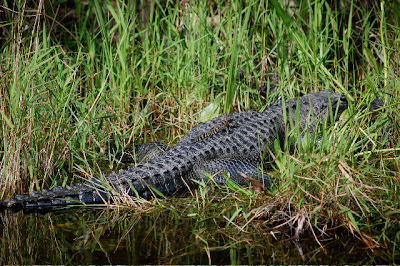
Momma Gator with a baby on her back
This national park is huge – over 1.4 million acres. Keep in mind that just a fraction of the overall Everglades ecosystem is deemed a national park. There are four entrances to the Everglades, and they are all open 365 days a year. (I just would not recommend you try to get in on a day when a hurricane is pending!) These include the Flamingo Center, Ernest Coe Visitor Center, Gulf Coast Visitor Center and Shark Valley.
Shark Valley is by far the best place to see the plants and animals up close. (On our way into the park, we recently saw a very large otter scurrying across the road.) The park has a 15-mile paved loop road, perfect for a bike ride or long walk. There are also guided tram tours that run throughout the day. If you plan to ride your bike (or rent one there) you may be riding against the wind for at least part of your journey, and the wind can be quite strong.
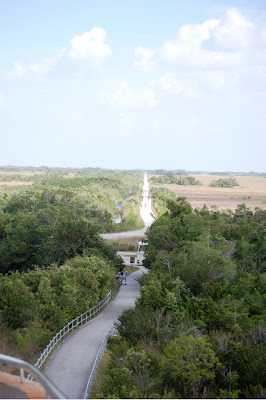
View from Shark Valley Observation Tower
So if you are traveling with very young children, or you are not in good physical condition, or cannot take hours of sun, I recommend the tram tour. The best time for visiting the park is between December and March, when the humidity is down and the temperatures are cooler. Remember to bring your sunscreen, plenty of water and your best camera. If you are renting a bike, arrive early, as they are often all rented out by mid morning during the busy winter months. Shark Valley opens at 8:30 a.m. each day.
The unique aspect about a visit to the Everglades is that nature is often camouflaged, and you must be patient and observant to uncover its greatest treasures. During the first mile of the journey you will have the easiest time spotting plants and animals. Alligators are everywhere, and you will see them overlapping on the road, just a few feet away from your own feet. They will leave you alone, if you leave them alone! Be sure to take your time through this initial part of your adventure, as you will certainly want to take photos and look up in the trees for Great Blue Herons, Egrets, White Ibis, Storks and others. Purple Gallinule are beautiful multi-colored birds you can spot in the water; their nests float on water lilies. Roseate Spoonbills are a spectacular site and are aptly named, with their pink color and spoon-like beaks. High in the sky you may see a giant Osprey flying overhead. One of the highlights is spotting turtles basking in the sun. Soft shell turtles are common as well as box turtles and others.
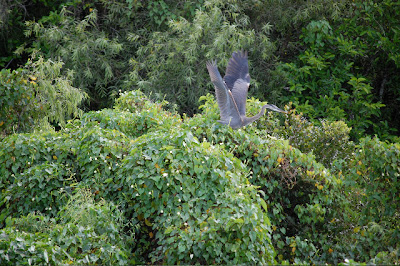
Great Blue Heron
About half way through the ride is an Observation Tower with a ramp you can climb for a bird’s-eye view of the area. There is a place to park your bikes, and you will find the break from peddling to be a true delight at this point in your journey! The walk into the observation area is generally teeming with alligators. They fancy the warm water that surrounds the tower. Each time I have been there, I have seen many extra large gators. This is a time when your telephoto lens will really come in handy! The panorama of the bike trail is quite impressive from up there as well. Note that there is a restroom facility here, the only one you will find until you return to the entrance.
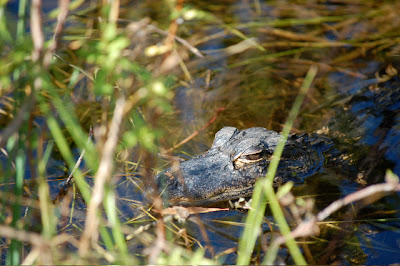
Gator lurking in the grass
Beware of bringing food and leaving your personal possessions accessible on your bikes. The last time I visited, a large crow swooped down and treated himself to a bag of chips from my bicycle basket. Another rider told us that his car keys were taken by a crow, which selfishly flew them high up into the air and dropped them deep into the wetlands, - never to be seen again. (I don’t believe there is a locksmith within 25 miles of Shark Valley!) Those crows are indeed bold. They know what they want and they generally get it. They even know how to open zippered packs on your bike!

Red Shouldered Hawk
The return back after the tower visit is sometimes much easier on the legs due to the wind being in your favor. During our last trip, we saw a gator guarding a tremendous half-eaten python. We were informed that the gator likely could not finish this huge meal, and needed to digest for a while before enjoying his dessert. Burmese pythons are a real threat to the Everglades. They are not endemic to this region and arrived here due to people releasing their snake pets they can no longer care for into the wild. That is not surprising, since these creatures can grow to 20 feet and weigh up to 200 pounds! Pythons seem to thrive in the Everglades, multiplying in vast numbers, enjoying the climate and devouring many natural species of mammals, birds, and eggs.

Gator guarding her prey - A Burmese Python
All along the bike path are many drain ducts that run underneath the road, where mommy gators can often be seen with babies on their backs. Don’t expect to see a Florida Panther here, though they are part of the park. Their numbers have dwindled down to just a few, as they are one of Florida’s most endangered species. Shark Valley does not have crocodiles either; you’ll have to access the park at the Flamingo Visitor Center to find them lurking in the brackish water.
Whatever natural delights you are treated to in Everglades National Park, you can never take it all in with just one visit. With more than 1,000 species of plants, 120 species of trees, 300 species of birds, 40 species of mammals, 50 species of reptiles, 20 species of amphibians and countless fish, each visit offers different discoveries. You will be sure to remember your experience here for years to come.
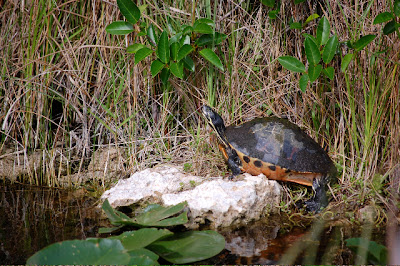
Redbellied Turtle
Before you go, visit the Everglades National Park official website at http://www.nps.gov/ever/
Smartpoodle/Debbie Glade is the Geography Awareness Editor for Wandering Educators.
All photos courtesy and copyright of Debbie Glade.
